The Color of Drinking is an exploratory study that examines how alcohol culture impacts campus climate, health and wellbeing, retention, and academics. The survey was administered on campus in 2015, 2017, and 2023. Results of the most recent survey are available below.
To request a presentation on The Color of Drinking, email colorofdrinking@uhs.wisc.edu.
